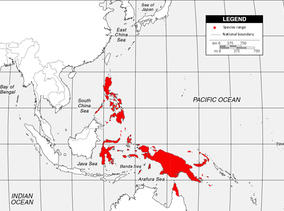You are here
Species
Pitta erythrogaster Temminck, 1823
SUMMARY
Red-bellied Pitta
Other common names: Blue-breasted/Red-breasted Pitta; Macklot’s Pitta (macklotii); Sula Pitta (dohertyi)
Pitta eythrogaster measures 16 – 18 cm; male weight 50 – 65 g,and female weight female 46 – 70 g. Adult of nominate race has crown, nape and neck side deep red-brown, cheeks cinnamon; upper mantle blue, lower mantle and back dark green (variable), rump and tail blue; upperwing-coverts mostly deep blue; flightfeathers black, variably edged blue, inner secondaries mostly blue, variable small white spots on primaries; upper throat brownish, lower throat and upper breast black, sometimes with white throatband, a broad glossy blue band across breast becoming green at sides (variable), rest of underparts scarlet; iris dark brown to reddish-brown, pale olive or bluish-slate; bill black; feet dark brown with lilac tinge to greyish-blue or pinkish-slate. Female is duller, more green and less blue on breast, red of underparts a shade paler. Small dusky stripes found on upperparts and blue breastband of 24% if 585 adults examined (both sexes, all races). Juvenile is dull brown above, rump and tail tip dull blue, paler below, throat whitish, breast with dark brown and off-white spots, bill dark horn, tip and base of lower mandible paler.
Races vary considerably in plumage details: propinqua is very like nominate, but on average brighter and slightly smaller; caeruleitorques has top of head more uniformly brownish-red, brighter on nape, black band between blue breast and red belly; cellebensis has variably sized blue stripe from middcrown to nape, more blue on breast with broad black band below; palliceps resembles last but paler, crown with less blue, little or no black on breast; inspeculata is distinctive, entire head dark chestnut-brown, upperparts all blue, breastband dark blue and narrow, iris grey-brown; dohetyi is also distinctive, with entire head, neck and throat black except for chestnut crown (variable), glossy green upperparts, also narrow light blue breastband with broad blackish band below, female with white iris; rufiventris has brighter reddish nape, dull dark green to dull blue rump, no blue on mantle, pale throat, more extensive blue on breast with thin black and greenish band below; cyanonota has nape bright rufous, upperparts dull blue, cheeks and throat pale buffy-brown, entire breast pale blue, sometimes thin black line below breast; bernsteini is marginally bigger than previous, slightly paler above, blue of breast silvery; rubrinucha has pale blue on rear crown centre and behind eye, small contrasting red area on nape, no blue on mantle; piroensisi resembles previous, but darker green above, larger red nape patch; macklotii has forecrown, face and throat dark, hindcrown and nape bright orange-rufous, ear-coverts and a stripe over eye tinged blue, no blue on mantle, black lower breastband of extremely variable depth; habenichti is very like last, but nape brighter red or orange-red; aruensis resembles previous two but smaller, occasionally some blue on mantle; loriae has darker head and nape, sometimes narrow blue line on upper mantle, bill larger; oblita has nape pale yellow-brown, perhaps bluer (less green) upperparts; novaehibernicae has walnut-brown crown, contrasting reddish-orange nape bluish ear-coverts, no black on throat or breast; exima is larger than last, with some blue feathers on midcrown, more bluish-green back; gazellae differs from last in usually stronter blue line on middcrown, redder crown side; splendida has nape scarlet, thin blackish hindcollar, upperparts deep blue, breast side blue; mekki is duller, throat more greyish, broad black lower breastband finely tipped red; finschii has crown to nape uniform dull dark chestnut, upperparts deep blue, female paler brown on chin and throat.


